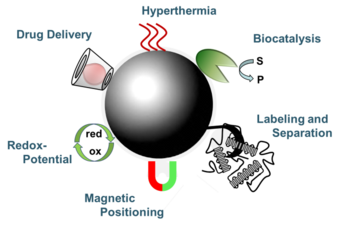Biofunctionalization
In recent years, biofunctional magnetic particles have attracted interest as nanoscopic carriers for biological and medical applications. They are of interest for improved separation systems and assays, targeted drug delivery, active (bio?)catalysis, and more. The functionalization process is shown to be effective and versatile when polymers are involved in a core-shell structure, either as a nanogel1 or a surface-attached brush.2 Employing functional monomers in the synthesis of the polymer phase, it is possible to introduce biologically or (bio)catalytically active groups.3 The inorganic particles serve as local antennas for energy absorption, and allow the easy separation and recovery of the multifunctional nanohybrids via magnetic fields.

We are interested in the development, optimization and application of biofunctional particles. Cyclodextrins are incorporated in the polymer shell for reversible immobilization of drugs due to entropically favored host-guest complex formation.4 The magneto-responsive release can be induced in AC fields.5 Further, magnetic hybrid particles are capable to separate proteins and biological components.6 Taking advantage of the redox properties and energy dissipation properties are explored for their potential in cancer therapy. Finally, functionalized magnetic particles can be targeted to special regions in human body.